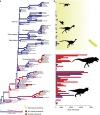Bony cranial ornamentation linked to rapid evolution of gigantic theropod dinosaurs
- PMID: 27676310
- PMCID: PMC5052652
- DOI: 10.1038/ncomms12931
Bony cranial ornamentation linked to rapid evolution of gigantic theropod dinosaurs
Abstract
Exaggerated cranial structures such as crests and horns, hereafter referred to collectively as ornaments, are pervasive across animal species. These structures perform vital roles in visual communication and physical interactions within and between species. Yet the origin and influence of ornamentation on speciation and ecology across macroevolutionary time scales remains poorly understood for virtually all animals. Here, we explore correlative evolution of osseous cranial ornaments with large body size in theropod dinosaurs using a phylogenetic comparative framework. We find that body size evolved directionally toward phyletic giantism an order of magnitude faster in theropod species possessing ornaments compared with unadorned lineages. In addition, we find a body mass threshold below which bony cranial ornaments do not originate. Maniraptoriform dinosaurs generally lack osseous cranial ornaments despite repeatedly crossing this body size threshold. Our study provides novel, quantitative support for a shift in selective pressures on socio-sexual display mechanisms in theropods coincident with the evolution of pennaceous feathers.
Figures


Similar articles
-
A bony-crested Jurassic dinosaur with evidence of iridescent plumage highlights complexity in early paravian evolution.Nat Commun. 2018 Jan 15;9(1):217. doi: 10.1038/s41467-017-02515-y. Nat Commun. 2018. PMID: 29335537 Free PMC article.
-
When did theropods become feathered?--evidence for pre-Archaeopteryx feathery appendages.J Exp Zool B Mol Dev Evol. 2004 Jul 15;302(4):355-64. doi: 10.1002/jez.b.20014. J Exp Zool B Mol Dev Evol. 2004. PMID: 15287100
-
Air-filled postcranial bones in theropod dinosaurs: physiological implications and the 'reptile'-bird transition.Biol Rev Camb Philos Soc. 2012 Feb;87(1):168-93. doi: 10.1111/j.1469-185X.2011.00190.x. Epub 2011 Jul 7. Biol Rev Camb Philos Soc. 2012. PMID: 21733078 Review.
-
Patterns of divergence in the morphology of ceratopsian dinosaurs: sympatry is not a driver of ornament evolution.Proc Biol Sci. 2018 Mar 28;285(1875):20180312. doi: 10.1098/rspb.2018.0312. Proc Biol Sci. 2018. PMID: 29563271 Free PMC article.
-
The theropod furcula.J Morphol. 2009 Jul;270(7):856-79. doi: 10.1002/jmor.10724. J Morphol. 2009. PMID: 19206153 Review.
Cited by
-
An Italian dinosaur Lagerstätte reveals the tempo and mode of hadrosauriform body size evolution.Sci Rep. 2021 Dec 2;11(1):23295. doi: 10.1038/s41598-021-02490-x. Sci Rep. 2021. PMID: 34857789 Free PMC article.
-
The nature of allometry in an exaggerated trait: The postocular flange in Platyneuromus Weele (Insecta: Megaloptera).PLoS One. 2017 Feb 17;12(2):e0172388. doi: 10.1371/journal.pone.0172388. eCollection 2017. PLoS One. 2017. PMID: 28212437 Free PMC article.
-
Macroevolutionary trends in Ceratosauria body size: insights of phylogenetic comparative methods.BMC Ecol Evol. 2025 Apr 12;25(1):32. doi: 10.1186/s12862-025-02374-y. BMC Ecol Evol. 2025. PMID: 40221646 Free PMC article.
-
Rise of the king: Gondwanan origins and evolution of megaraptoran dinosaurs.R Soc Open Sci. 2025 May 7;12(5):242238. doi: 10.1098/rsos.242238. eCollection 2025. R Soc Open Sci. 2025. PMID: 40337259 Free PMC article.
-
Extreme armour in the world's oldest ankylosaur.Nature. 2025 Aug 27. doi: 10.1038/s41586-025-09453-6. Online ahead of print. Nature. 2025. PMID: 40866695
References
-
- Andersson M. B. Sexual Selection Princeton University Press (1994).
-
- Emlen D. J. The evolution of animal weapons. Annu. Rev. Ecol. Evol. Syst. 39, 387–413 (2008).
-
- Darwin C. The Descent of Man, and Selection in Relation to Sex John Murray (1871).
-
- McCullough E. L., Miller C. W. & Emlen D. J. Why sexually selected weapons are not ornaments. Trends Ecol. Evol. (2016). - PubMed
-
- Knell R. J., Naish D., Tomkins J. L. & Hone D. W. Sexual selection in prehistoric animals: detection and implications. Trends Ecol. Evol. 28, 38–47 (2013). - PubMed
LinkOut - more resources
Full Text Sources
Other Literature Sources

